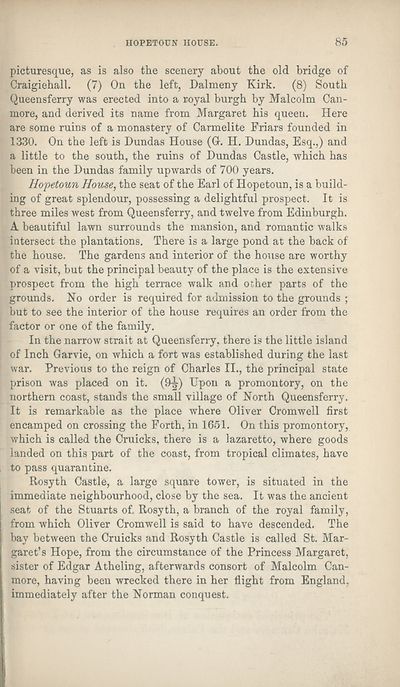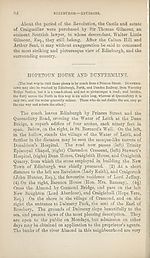Download files
Complete book:
Individual page:
Thumbnail gallery: Grid view | List view

HOPETOUN HOUSE.
85
picturesque, as is also the scenery about the old bridge of
Craigiehall. (7) On the left, Dalmeny Kirk. (8) South
Queensferry was erected into a royal burgh by Malcolm Can-
more, and derived its name from Margaret his queen. Here
are some ruins of a monastery of Carmelite Friars founded in
1330. On the left is Dundas House (Q-. H. Dundas, Esq.,) and
a little to the south, the ruins of Dundas Castle, which has
been in the Dundas family upwards of 700 years.
Hopetoun House, the seat of the Earl of Hopetoun, is a build¬
ing of great splendour, possessing a delightful prospect. It is
three miles west from Queensferry, and twelve from Edinburgh.
• A beautiful lawn surrounds the mansion, and romantic walks
intersect the plantations. There is a large pond at the back of
the house. The gardens and interior of the house are worthy
of a visit, but the principal beauty of the place is the extensive
prospect from the high terrace walk and other parts of the
grounds. No order is required for admission to the grounds ;
but to see the interior of the house requires an order from the
factor or one of the family.
In the narrow strait at Queensferry, there is the little island
of Inch Garvie, on which a fort was established during the last
war. Previous to the reign of Charles II., the principal state
prison was placed on it. (&J) Upon a promontory, on the
northern coast, stands the small village of North Queensferry.
It is remarkable as the place where Oliver Cromwell first
encamped on crossing the Forth, in 1651. On this promontory,
which is called the Cruicks, there is a lazaretto, where goods
landed on this part of the coast, from tropical climates, have
to pass quarantine.
Rosyth Castle, a large square tower, is situated in the
immediate neighbourhood, close by the sea. It was the ancient
seat of the Stuarts of. Rosyth, a branch of the royal family,
from which Oliver Cromwell is said to have descended. The
bay between the Cruicks and Rosyth Castle is called St. Mar¬
garet’s Hope, from the circumstance of the Princess Margaret,
sister of Edgar Atheling, afterwards consort of Malcolm Can-
more, having been wrecked there in her flight from England,
immediately after the Norman conquest.
85
picturesque, as is also the scenery about the old bridge of
Craigiehall. (7) On the left, Dalmeny Kirk. (8) South
Queensferry was erected into a royal burgh by Malcolm Can-
more, and derived its name from Margaret his queen. Here
are some ruins of a monastery of Carmelite Friars founded in
1330. On the left is Dundas House (Q-. H. Dundas, Esq.,) and
a little to the south, the ruins of Dundas Castle, which has
been in the Dundas family upwards of 700 years.
Hopetoun House, the seat of the Earl of Hopetoun, is a build¬
ing of great splendour, possessing a delightful prospect. It is
three miles west from Queensferry, and twelve from Edinburgh.
• A beautiful lawn surrounds the mansion, and romantic walks
intersect the plantations. There is a large pond at the back of
the house. The gardens and interior of the house are worthy
of a visit, but the principal beauty of the place is the extensive
prospect from the high terrace walk and other parts of the
grounds. No order is required for admission to the grounds ;
but to see the interior of the house requires an order from the
factor or one of the family.
In the narrow strait at Queensferry, there is the little island
of Inch Garvie, on which a fort was established during the last
war. Previous to the reign of Charles II., the principal state
prison was placed on it. (&J) Upon a promontory, on the
northern coast, stands the small village of North Queensferry.
It is remarkable as the place where Oliver Cromwell first
encamped on crossing the Forth, in 1651. On this promontory,
which is called the Cruicks, there is a lazaretto, where goods
landed on this part of the coast, from tropical climates, have
to pass quarantine.
Rosyth Castle, a large square tower, is situated in the
immediate neighbourhood, close by the sea. It was the ancient
seat of the Stuarts of. Rosyth, a branch of the royal family,
from which Oliver Cromwell is said to have descended. The
bay between the Cruicks and Rosyth Castle is called St. Mar¬
garet’s Hope, from the circumstance of the Princess Margaret,
sister of Edgar Atheling, afterwards consort of Malcolm Can-
more, having been wrecked there in her flight from England,
immediately after the Norman conquest.
Set display mode to:
![]() Universal Viewer |
Universal Viewer | ![]() Mirador |
Large image | Transcription
Mirador |
Large image | Transcription
| Antiquarian books of Scotland > Scotland/Scots > Black's picturesque tourist of Scotland > (141) |
|---|
| Permanent URL | https://digital.nls.uk/130029882 |
|---|
| Description | Thousands of printed books from the Antiquarian Books of Scotland collection which dates from 1641 to the 1980s. The collection consists of 14,800 books which were published in Scotland or have a Scottish connection, e.g. through the author, printer or owner. Subjects covered include sport, education, diseases, adventure, occupations, Jacobites, politics and religion. Among the 29 languages represented are English, Gaelic, Italian, French, Russian and Swedish. |
|---|

